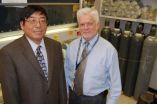(Press-News.org) At home, in the car or with industrial processes – glass is a universal material. Its properties are so extraordinary that frequently there are no alternatives to this material. Take, for example, high-temperature fuel cells, in which layers of ceramics and metals are alternately attached to each other: to ensure no explosive hydrogen escapes, the metal and ceramic layers must be firmly bound to each other, and the seam must be sealed tight. Only glass can accomplish this type of seal – and here, we are specifically referring to solder glass. But how does glass behave at such high temperatures? To what extent does it enlarge? Until now, this question was investigated using a push rod, which pushes from the glass onto a cylinder. If the glass heats up, then it expands and pushes back against the push rod. Were the glass to become molten, however, then it adheres to the push rod and renders it unusable. Even if seeking to create glass with new qualities, scientists need reliable, efficient and simple methods in order to investigate the characteristics of the glass.
Researchers from the Fraunhofer Institute for Silicate Research ISC in Wertheim have just developed a thermooptical measuring device that makes the comprehensive characterization of glass possible. "With our system, we can study all glass characteristics simultaneously for the first time ever – and that on a laboratory scale, in other words, with minimal sample material," says Dr. Andreas Diegeler, head of the Center of Device Development at ISC. This system consists of an oven that a CMOS camera "looks into." This camera enables the researchers to observe the glass during the entire heating process.
The centerpiece for glass characterization is the maximum bubble pressure module, which the scientists can use to measure the viscosity and the surface tension of the glass under molten conditions. The principle behind this concept: The glass is heated in a crucible made of quartz glass. Since quartz glass has a higher melting point (about 1600 degrees Celsius) than other glass, the quartz glass crucible remains solid while the study glass slowly melts in it. A quartz glass capillary – in other words, a pipette with an inner diameter of one to three millimeters – is dipped, on a fully-automated basis, into the molten glass through a hole in the roof of the oven. A precisely defined volume of glass is likewise blown on a fully-automated basis through this pipette into the glass melt. The capillaries in the molten glass are like a drinking straw in a glass of soda: Blow air through the drinking straw into the beverage, and bubbles emerge. Do the same thing with yoghurt and you see fewer bubbles. Similarly, the researchers can determine the viscosity (flow resistance) of the glass based on the way in which the bubbles develop, and they can also establish the surface tension of the molten glass. Using the thermooptic measurement principle, they can additionally define other basic qualities of the glass, such as thermal expansion, under application-related conditions.
The process delivers a number of advantages: "On the one hand, it saves time: With the thermooptical system, glass can be characterized at least five times faster than previously. Because instead of having to produce and individually analyze five samples just to study five characteristic viscosity points of the glass, now we only need one sample, which is studied in only one heating operation. In addition, the process helps save on resources. Since we only need one sample instead of five, we spare 80 percent of the material – on a small scale, naturally," Diegeler summarizes. However, this system delivers outstanding services for more than glass alone. It can be used for any type of melting, whether steel or slag. Another interesting alternative: For test purposes, instead of blowing a gas into the glass that does not react with glass, one can also introduce gas that generates a chemical reaction with the glass, thereby changing its characteristics. This could be an alternative way of developing entirely new types of glass.
The system is already on the market – some customers are already working with it. Researchers will demonstrate the process at the Glasstec trade fair from October 23 to 26 in Düsseldorf (Hall 15, Booth E25).
### END
Glass: Characterizing with precision and efficiency
2012-10-26
ELSE PRESS RELEASES FROM THIS DATE:
Scientists step up hunt for bacterial genes tied to Lyme disease
2012-10-26
Investigators at The University of Texas Health Science Center at Houston (UTHealth) have accelerated the search for the bacterial genes that make the Lyme disease bacterium so invasive and persistent. The discovery could advance the diagnosis and treatment of this disease, which affects an estimated 30,000 Americans each year.
The researchers have developed a new technique that allowed them to test 15 times more bacterial genes than had been evaluated in the previous 30 years to ascertain their roles in infection. Findings appeared Oct. 25 in the journal The Public Library ...
Hermit crabs socialize to evict their neighbors
2012-10-26
Social animals usually congregate for protection or mating or to capture bigger prey, but a University of California, Berkeley, biologist has found that the terrestrial hermit crab has a more self-serving social agenda: to kick another crab out of its shell and move into a larger home.
All hermit crabs appropriate abandoned snail shells for their homes, but the dozen or so species of land-based hermit crabs – popular terrarium pets – are the only ones that hollow out and remodel their shells, sometimes doubling the internal volume. This provides more room to grow, more ...
NASA sees Tropical Storm Son-tinh moving through South China Sea
2012-10-26
NASA's Terra satellite got a good look at Tropical Storm Son-tinh moving through the South China Sea and headed for landfall in Vietnam.
NASA's Terra satellite flew over Son-Tinh on Oct. 26 at 0305 UTC (Oct. 25 at 11:05 p.m. EDT) and the Moderate Resolution Imaging Spectroradiometer (MODIS) instrument aboard captured a visible image of the storm. At the time, Son-tinh's western edge had already moved away from the Philippines. The image revealed powerful thunderstorms in the northwestern quadrant of the storm, and in the storm's center.
On Oct. 26 at 1500 UTC, Tropical ...
Drug shows promise in animal model of Alzheimer's and Parkinson's with dementia
2012-10-26
New research presented in October at the 6th Neurodegenerative Conditions Research and Development Conference in San Francisco demonstrates the role of the investigational compound IRX4204 in alleviating cognitive decline in animal models of Alzheimer's disease (AD). The presentation entitled "Investigation of the RXR-specific agonist IRX4204 as a Disease Modifying Agent of Alzheimer's Disease Neuropathology and Cognitive Impairment" was made by lead researcher Giulio Maria Pasinetti, MD, PhD, of the Mount Sinai School of Medicine in New York City.
IRX4204 is a retinoid ...
Stroke survivors who smoke raise risk of more strokes, heart attack, death
2012-10-26
Stroke survivors who smoke put themselves at a greater risk of additional strokes, heart attack or death than those who never smoked, according to new research in the American Heart Association's journal Stroke.
Those who quit smoking before their stroke also had less risk of poorer outcomes than current smokers, researchers found.
Researchers in Melbourne, Australia, tracked 1,589 patients who experienced a first or recurrent stroke in 1996-99. They followed them for 10 years, using medical records and in-person and telephone interviews, and tracked demographics, ...
C'est difficile
2012-10-26
In a new study out today, researchers used mice to identify a combination six naturally occurring bacteria that eradicate a highly contagious form of Clostridium difficile, an infectious bacterium associated with many hospital deaths. Three of the six bacteria have not been described before. This work may have significant implications for future control and treatment approaches.
The researchers found that this strain of C. difficile, known as O27, establishes a persistent, prolonged contagious period, known as supershedding that is very difficult to treat with antibiotics. ...
Researchers at the doorstep of stem cell therapies for MS, other myelin disorders
2012-10-26
When the era of regenerative medicine dawned more than three decades ago, the potential to replenish populations of cells destroyed by disease was seen by many as the next medical revolution. However, what followed turned out not to be a sprint to the clinic, but rather a long tedious slog carried out in labs across the globe required to master the complexity of stem cells and then pair their capabilities and attributes with specific diseases.
In a review article appearing today in the journal Science, University of Rochester Medical Center scientists Steve Goldman, ...
Traditional fisheries management approach jeopardizes marine ecosystems worldwide
2012-10-26
STONY BROOK, NY– In a Perspectives article, "The Risks of Overfishing," published today in the journal Science, Dr. Ellen K. Pikitch, executive director of the Institute for Ocean Conservation Science and professor at Stony Brook University, cautions against continuing traditional fisheries management. According to Dr. Pikitch, current and recent studies demonstrate the need for "a more precautionary approach to fisheries management, in which fishing is restricted to those places and amounts where it can be conducted safely and with minimal risk of jeopardizing the integrity ...
'Adoption activity days' can help children find new families
2012-10-26
Children's parties or activity days, where prospective adopters meet children awaiting adoption, could be part of the solution to the current adoption crisis, according to research that will be showcased during the Economic and Social Research Council (ESRC) Festival of Social Science.
"Such parties or activity days went out of fashion in the 1980s but no one is sure why," says Katherine Runswick-Cole of Manchester Metropolitan University who led the research. "However, our pilot study has shown an overwhelmingly positive response from practitioners, adopters and the ...
A black widow's Tango Mortale in gamma-ray light
2012-10-26
This press release is available in German.
Pulsars are the compact remnants from explosions of massive stars. Some of them spin around their own axis hundreds of times per second, emitting beams of radiation into space. Until now, they could only be found through their pulsed radio emissions. Now, scientists at the Max Planck Institute for Gravitational Physics (Albert Einstein Institute/AEI) in Hanover assisted by the Max Planck Institute for Radio Astronomy have discovered a millisecond pulsar solely via its pulsed gamma radiation. A new data analysis method developed ...




